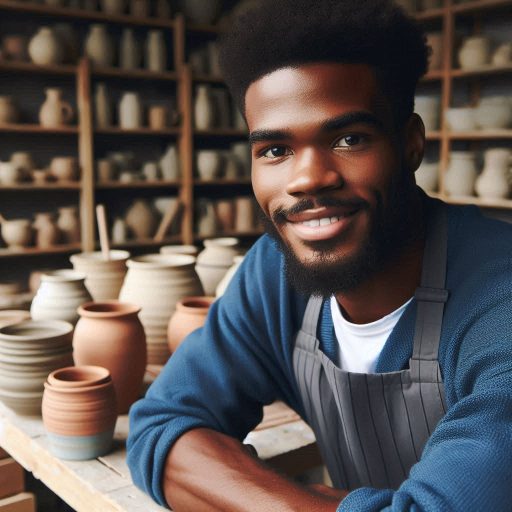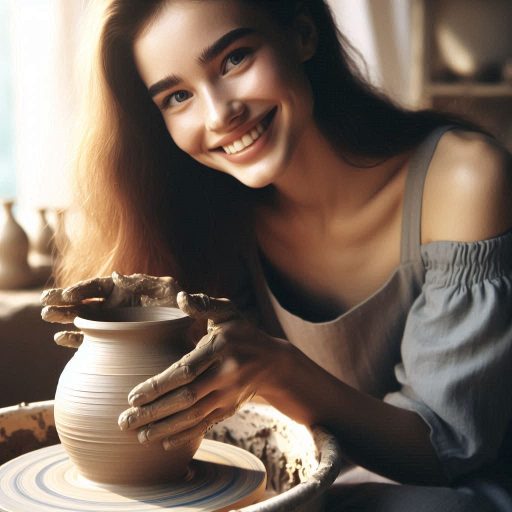Introduction
Printmaking has a rich history that dates back to ancient civilizations.
Early methods include woodcuts and engravings used in China and Europe.
The invention of the Gutenberg press in the 15th century revolutionized printmaking.
This press allowed for mass production of texts and images.
In the 19th century, lithography and etching techniques expanded artistic possibilities.
The 20th century saw the rise of modern printmaking with experimental techniques and materials.
These developments have laid the groundwork for today’s innovative approaches.
Innovative materials are transforming printmaking in significant ways.
They offer artists new tools to express creativity and push boundaries.
For example, digital technologies have introduced new printing methods and materials.
Artists now use non-traditional substrates like metal, fabric, and acrylics.
These materials provide unique textures and effects not possible with traditional papers.
Additionally, eco-friendly materials and processes address environmental concerns in printmaking.
The integration of these materials allows for greater experimentation and expression.
Overall, embracing innovative materials enhances the diversity and impact of contemporary printmaking.
Definition of Printmaking
Traditional Printmaking Techniques
Printmaking is an art form involving creating multiple copies of an image.
Traditional techniques include woodcut, etching, and lithography.
In woodcut, artists carve into woodblocks, ink them, and press them onto paper.
Etching involves creating images on a metal plate using acid to bite into the surface.
Lithography uses a flat stone or metal plate where artists draw with grease, then apply ink to create prints.
Transform Your Career Today
Unlock a personalized career strategy that drives real results. Get tailored advice and a roadmap designed just for you.
Start NowThese methods are known for their unique textures and qualities, producing distinctive visual effects.
Introduction to Modern Advancements in Printmaking Materials
Modern advancements in printmaking materials have revolutionized the field.
Contemporary artists use innovative materials such as synthetic plates and eco-friendly inks.
Plastic plates replace traditional metal ones, offering greater flexibility and durability.
Water-based inks have become popular for their environmental benefits and ease of clean-up.
Digital printmaking allows artists to create and reproduce images using computer technology, expanding creative possibilities.
These modern materials enhance the versatility and accessibility of printmaking, pushing the boundaries of traditional practices.
Read: The Impact of Printmaking on Pop Culture
Types of innovative materials used in printmaking
Water-based inks and paints
Water-based inks and paints are a popular choice among printmakers today due to their environmentally friendly nature.
These materials are non-toxic and easily washable, making them safe to use in a studio setting.
They also offer vibrant colors and smooth application, giving artists more control over their prints.
One of the key advantages of using water-based inks and paints is their ability to be mixed and layered, creating unique effects and textures in the final print.
Printmakers can experiment with different techniques such as mono-printing, layering, and stenciling to achieve a variety of results.
Digital printing technology
With advancements in digital printing technology, printmakers now have access to a wide range of innovative tools and techniques.
Digital printers allow artists to transfer their designs directly onto various surfaces, including paper, canvas, and even wood.
One of the main benefits of digital printing technology is its precision and efficiency.
Artists can easily manipulate their designs using software programs like Photoshop, Illustrator, or CorelDRAW to achieve the desired look.
This level of control and accuracy is essential for artists working on complex projects or custom orders.
Alternative surfaces like fabric and wood
In addition to traditional paper, printmakers are now exploring alternative surfaces like fabric and wood to create unique and visually striking prints.
Fabric printing, for example, offers a soft and tactile quality to the final artwork, while woodblock printing allows for intricate details and textures.
Transform Your Career Today
Unlock a personalized career strategy that drives real results. Get tailored advice and a roadmap designed just for you.
Start NowBy experimenting with different surfaces, printmakers can push the boundaries of traditional printmaking techniques and create innovative and unconventional works of art.
These materials also open up new creative possibilities, inspiring artists to explore new themes and styles in their practice.
In short, the use of innovative materials in printmaking today has revolutionized the way artists create and showcase their work.
From water-based inks and paints to digital printing technology and alternative surfaces, printmakers now have a plethora of options to experiment with and push the boundaries of traditional printmaking.
By embracing these new materials, artists can continue to evolve their practice and engage with audiences in exciting and innovative ways.
Read: Networking Tips for Printmaking Artists
Benefits of using innovative materials in printmaking
Increased Artistic Freedom and Experimentation
Innovative materials in printmaking offer artists a wide range of options to explore different techniques and styles.
Artists can push the boundaries of traditional printmaking and create unique and original works.
Enhanced Quality and Detail in Prints
The use of new materials allows artists to achieve greater precision and sharpness in their prints.
These materials can enhance the texture, color, and overall look of the final piece.
Sustainability and Eco-Friendliness of New Materials
Many innovative materials used in printmaking today are eco-friendly and sustainable.
Artists can reduce their environmental impact by choosing materials that are recyclable or biodegradable.
Basically, embracing innovative materials in printmaking not only expands artistic possibilities but also contributes to a more sustainable and environmentally conscious practice.
Read: Understanding Glazes and Firing Techniques

Challenges of working with innovative materials in printmaking
Learning curve for new techniques
Embracing innovative materials in printmaking often involves learning new techniques that may be unfamiliar to artists.
This learning curve can sometimes be steep, requiring patience and dedication to master.
Exploring unconventional materials such as 3D printing resins or conductive inks may require artists to adapt their creative process and experiment with new methods.
This shift in approach can be both challenging and rewarding, as artists push the boundaries of traditional printmaking.
Cost implications of using specialized materials
One of the major challenges of working with innovative materials in printmaking is the cost implications involved.
Specialized materials such as holographic foils or UV-sensitive inks can be expensive, making them inaccessible to some artists.
Transform Your Career Today
Unlock a personalized career strategy that drives real results. Get tailored advice and a roadmap designed just for you.
Start NowInvesting in new materials also means artists need to consider the long-term sustainability of their practice.
Balancing the need for quality materials with budget constraints is crucial for artists looking to incorporate innovative techniques into their work.
Compatibility issues with traditional printmaking tools
Integrating innovative materials into traditional printmaking processes can present compatibility issues with existing tools.
Printmakers may need to modify their equipment or acquire new tools to accommodate the unique properties of these materials.
For example, working with heat-sensitive thermochromic inks may require artists to adjust printing temperature settings or invest in specialized heating devices.
This need for adaptation can add complexity to the printmaking process but also opens up new creative possibilities.
All in all, while working with innovative materials in printmaking presents various challenges, the opportunity to explore new techniques and push the boundaries of traditional practices is invaluable.
By overcoming these obstacles, artists can elevate their work and create truly unique and groundbreaking pieces.
Read: Balancing Creativity and Business in Ceramic Art
Examples of Contemporary Printmakers Using Innovative Materials
Contemporary printmaking is evolving rapidly, with artists pushing traditional boundaries.
They explore new materials to create unique, impactful works.
These innovators transform printmaking by integrating unexpected substances and techniques.
Artists Pushing the Boundaries of Traditional Printmaking
Many artists now experiment with unconventional materials.
They incorporate items like recycled plastics, metal foils, and fabric into their prints.
This experimentation expands the texture, depth, and visual appeal of traditional prints.
For instance, artists use 3D printing technology to create complex, layered prints that defy conventional methods.
By blending these materials with traditional ink and paper, they achieve novel aesthetic effects and textures.
These methods challenge conventional expectations and broaden the scope of what printmaking can be.
Success Stories of Artists Experimenting with New Materials
Several contemporary printmakers have achieved notable success by using innovative materials.
For example, artist Emma Haugh has gained acclaim for her use of biodegradable materials in printmaking.
Transform Your Career Today
Unlock a personalized career strategy that drives real results. Get tailored advice and a roadmap designed just for you.
Start NowHer work highlights sustainability while creating visually striking prints.
Similarly, the work of Brian Shure, who integrates LED lights into his prints, merges technology with traditional techniques.
These examples showcase how experimenting with new materials can lead to groundbreaking results and influence the wider art community.
Profiles of Printmakers Using Innovative Materials in Their Work
Printmakers like Tara O’Brien and Marco Berti exemplify the innovative use of materials.
O’Brien’s prints often feature elements like fabric and metal, adding a tactile dimension to her work.
Berti’s prints incorporate digital elements and augmented reality, engaging viewers in interactive experiences.
These artists not only challenge the norms but also inspire others to explore new possibilities.
Their work reflects the dynamic potential of contemporary printmaking and encourages further exploration of innovative materials.
Through their creativity, these artists redefine printmaking, offering fresh perspectives and pushing the art form into exciting new territories.
Future trends in innovative materials for printmaking
Advancements in digital printing technology
As technology continues to evolve, digital printing techniques are becoming more refined and accessible.
Artists now have a wide range of tools at their disposal, including high-resolution printers and innovative software programs.
These advancements allow artists to experiment with different textures, colors, and effects, creating unique prints that were previously unattainable.
Digital printing also offers the flexibility to make changes on the fly, saving time and resources in the process.
With the ability to print on a variety of surfaces, from paper to fabric to metal, artists can explore new mediums and push the boundaries of traditional printmaking techniques.
As digital printing technology improves, we can expect to see even more innovative materials being utilized in the printmaking process.
Shift towards sustainable and recycled materials
As the environmental impact of traditional printing methods becomes more apparent, there is a growing trend towards using sustainable and recycled materials in printmaking.
Artists are increasingly seeking out eco-friendly alternatives, such as soy-based inks and recycled paper.
By incorporating these materials into their work, artists are not only reducing their carbon footprint but also creating prints with a unique texture and aesthetic.
This shift towards sustainability is not only beneficial for the environment but also adds an extra layer of meaning and depth to the artwork.
With consumers becoming more conscious of the products they purchase, using sustainable materials can also help artists attract a wider audience and differentiate themselves in the competitive art market.
Transform Your Career Today
Unlock a personalized career strategy that drives real results. Get tailored advice and a roadmap designed just for you.
Start NowAs the demand for eco-friendly art continues to rise, we can expect to see more artists experimenting with sustainable materials in their printmaking process.
Collaborations between artists and material manufacturers for new innovations
To stay ahead of the curve, artists are increasingly collaborating with material manufacturers to develop new and innovative materials for printmaking.
These partnerships allow artists to gain access to cutting-edge materials and techniques, giving them the ability to push the boundaries of traditional printmaking techniques.
By working closely with manufacturers, artists can experiment with materials that are not readily available to the general public, creating prints that stand out from the crowd.
These collaborations also provide artists with the opportunity to showcase their work at a larger scale, reaching a broader audience and gaining recognition for their innovative approach to printmaking.
As these collaborations continue to grow, we can expect to see even more exciting and groundbreaking materials being introduced into the world of printmaking.
By combining the creativity of artists with the expertise of material manufacturers, the possibilities are endless for the future of printmaking.
Essentially, the future of printmaking is bright, with artists embracing new technologies and materials to create innovative and sustainable prints that push the boundaries of traditional techniques.
By staying ahead of trends and collaborating with experts in the field, artists can continue to make their mark in the ever-evolving world of printmaking.
Conclusion
As we wrap up our discussion on innovative materials in printmaking today, it is essential to highlight their significance in pushing the boundaries of traditional techniques.
By using unconventional materials, artists can create unique and eye-catching prints that challenge perceptions and inspire creativity.
Therefore, I encourage artists to continue exploring new materials and techniques in their work.
Embracing innovation in printmaking not only allows for personal growth but also contributes to the evolution of the medium as a whole.
Looking ahead, the future of printmaking is filled with excitement and endless possibilities.
With ongoing advancements in materials and technology, there is no limit to what artists can achieve in this dynamic and ever-changing field.




